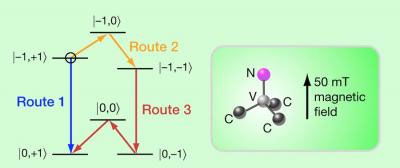Home > Press > Turning Down the Noise in Quantum Data Storage
 |
| Driving a qubit along a longer quantum path (routes 2 and 3) dramatically improves the signal quality over that achieved by following the shorter path (route 1). The research applies to information stored in qubits that consisted of Nitrogen-based defects in diamond, as schematically shown on the right. Credit: Alan Stonebraker. Article in Physics physics.aps.org/articles/v3/6 |
Abstract:
A roundabout method of reading data can improve quantum memory
Turning Down the Noise in Quantum Data Storage
College Park, MD | Posted on February 11th, 2010Researchers who hope to create quantum computers are currently investigating various methods to store data. Nitrogen atoms embedded in diamond show promise for encoding quantum bits (qubits), but the process of reading the information results in an extremely weak signal.
Now physicists have demonstrated a roundabout approach for generating a significantly stronger signal from these sorts of qubits. Their experiment is reported in the current issue of Physical Review B and highlighted with a Viewpoint in the January 19 issue of Physics.
In a quantum computer, a single bit of information is encoded into a property of a quantum mechanical system—the spin of an electron, for example. In most arrangements that rely on Nitrogen atoms in diamond to store data, reading the information also resets the qubit, which means there is only one opportunity to measure the state of the qubit. By developing a technique that involves the spin of the Nitrogen nucleus in the process as well, a team of physicists at the University of Stuttgart in Germany has turned the single step read-out into a multi-step process.
Rather than simply resetting the electron-based qubit when the information is read, the researchers discovered that they can force the state of the Nitrogen nucleus to change state twice before the information in the qubit is finally erased. The state of the Nitrogen nucleus doesn't store any useful information, it simply allows the researchers to add steps to the process of reading the qubit's state. This results in a more convoluted quantum mechanical process that triples the number of events that occur before information is destroyed, which in turn strengthens the signal revealing information stored in the qubit.
The resulting signal is still weak, but by combining other clever methods to the problem researchers might one day be able to use impurities in diamond to read and write quantum information at room temperature—which would bring us much closer to creating practical quantum computers.
####
About APS Physics
APS Physics publishes expert written commentaries and highlights of papers appearing in the journals of the American Physical Society.
For more information, please click here
Contacts:
James Riordon
APS Head of Media Relations
301-209-3238
Copyright © APS Physics
If you have a comment, please Contact us.Issuers of news releases, not 7th Wave, Inc. or Nanotechnology Now, are solely responsible for the accuracy of the content.
| Related News Press |
News and information
![]() Researchers develop molecular qubits that communicate at telecom frequencies October 3rd, 2025
Researchers develop molecular qubits that communicate at telecom frequencies October 3rd, 2025
![]() Next-generation quantum communication October 3rd, 2025
Next-generation quantum communication October 3rd, 2025
![]() "Nanoreactor" cage uses visible light for catalytic and ultra-selective cross-cycloadditions October 3rd, 2025
"Nanoreactor" cage uses visible light for catalytic and ultra-selective cross-cycloadditions October 3rd, 2025
Possible Futures
![]() Spinel-type sulfide semiconductors to operate the next-generation LEDs and solar cells For solar-cell absorbers and green-LED source October 3rd, 2025
Spinel-type sulfide semiconductors to operate the next-generation LEDs and solar cells For solar-cell absorbers and green-LED source October 3rd, 2025
Memory Technology
![]() Researchers tackle the memory bottleneck stalling quantum computing October 3rd, 2025
Researchers tackle the memory bottleneck stalling quantum computing October 3rd, 2025
![]() First real-time observation of two-dimensional melting process: Researchers at Mainz University unveil new insights into magnetic vortex structures August 8th, 2025
First real-time observation of two-dimensional melting process: Researchers at Mainz University unveil new insights into magnetic vortex structures August 8th, 2025
![]() Utilizing palladium for addressing contact issues of buried oxide thin film transistors April 5th, 2024
Utilizing palladium for addressing contact issues of buried oxide thin film transistors April 5th, 2024
Quantum Computing
![]() Researchers develop molecular qubits that communicate at telecom frequencies October 3rd, 2025
Researchers develop molecular qubits that communicate at telecom frequencies October 3rd, 2025
![]() Researchers tackle the memory bottleneck stalling quantum computing October 3rd, 2025
Researchers tackle the memory bottleneck stalling quantum computing October 3rd, 2025
![]() Japan launches fully domestically produced quantum computer: Expo visitors to experience quantum computing firsthand August 8th, 2025
Japan launches fully domestically produced quantum computer: Expo visitors to experience quantum computing firsthand August 8th, 2025
Announcements
![]() Rice membrane extracts lithium from brines with greater speed, less waste October 3rd, 2025
Rice membrane extracts lithium from brines with greater speed, less waste October 3rd, 2025
![]() Researchers develop molecular qubits that communicate at telecom frequencies October 3rd, 2025
Researchers develop molecular qubits that communicate at telecom frequencies October 3rd, 2025
![]() Next-generation quantum communication October 3rd, 2025
Next-generation quantum communication October 3rd, 2025
![]() "Nanoreactor" cage uses visible light for catalytic and ultra-selective cross-cycloadditions October 3rd, 2025
"Nanoreactor" cage uses visible light for catalytic and ultra-selective cross-cycloadditions October 3rd, 2025
Quantum nanoscience
![]() ICFO researchers overcome long-standing bottleneck in single photon detection with twisted 2D materials August 8th, 2025
ICFO researchers overcome long-standing bottleneck in single photon detection with twisted 2D materials August 8th, 2025
![]() Programmable electron-induced color router array May 14th, 2025
Programmable electron-induced color router array May 14th, 2025
|
|
||
|
|
||
| The latest news from around the world, FREE | ||
|
|
||
|
|
||
| Premium Products | ||
|
|
||
|
Only the news you want to read!
Learn More |
||
|
|
||
|
Full-service, expert consulting
Learn More |
||
|
|
||








